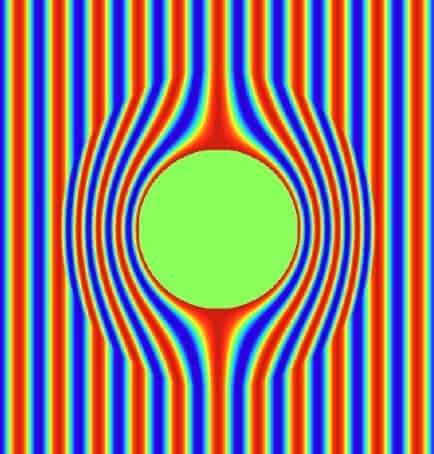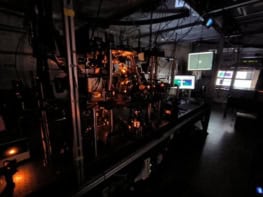
Two independent teams of researchers have come up with a recipe for making special materials that could completely cloak an object from sound. Although the “acoustic metamaterials” have yet to be made, a third team is now trying to create a real cloak.
These metamaterials promise to guide sound waves around an enshrouded object as if the object wasn’t there. As well as being used to conceal submarines from detection by sonar, such metamaterials could be used to improve the acoustics in concert halls.
Electromagnetic cloaks
Over the past few years physicists have shown that it should be possible to create materials that can be used to cloak objects from electromagnetic radiation such as microwaves or light. Indeed, in some very special situations, such “invisibility cloaks” have actually been built.
Sound propagates as waves and physicists had suspected that it should be possible to create similar “acoustic cloaks”. For example, it is relatively easy to show mathematically that sound waves impinging on a cylindrically-shaped acoustic cloak behave in much the same way as electromagnetic waves on a cylindrically-shaped invisibility cloak.
However, cylindrical cloaks only work for waves travelling perpendicular to the axis of the cylinder — which is why they are called “2D” cloaks. A true “3D” cloak that would work for waves coming from all directions would have to be spherical in shape. Until recently, some physicists had argued that 3D acoustic cloaks were a mathematical impossibility — but now, two independent teams of researchers have shown that it should be possible
Density and compressibility
One team, led by Steven Cummer at Duke University in the US, used the mathematics describing how sound scatters from materials to come up with a recipe that defines the density and compressibility of a spherical shell that would act as an acoustic cloak (Phys. Rev. Lett. 100 024301). These properties would have to vary across the thickness of the shell and crucially, would have to appear to be different for sound waves moving in different directions. No natural materials have such properties, and therefore such a cloak would have to be made from a “metamaterial” that contains manmade structures.
The second team — Huanyang Chen and Che Ting Chan of the Hong Kong University of Science and Technology — managed to show that the equations describing a spherical acoustic cloak were indeed the same as those describing a spherical electromagnetic cloak (Appl. Phys. Lett. 91 183518). This led them to the same recipe proposed by Cummer and colleagues.
Matrix of cylindrical rods
The considerable challenge of building an acoustic cloak has been taken up by José Sánchez-Dehesa and colleagues at the Polytechnic University of Valencia in Spain. The team has calculated that a cylindrical cloak can be made by surrounding the region to be cloaked with a matrix of cylindrical rods (New Journal of Physics 10 023004). By choosing rods with the right elastic properties and by varying the radius and spacing of the rods, Sánchez-Dehesa believes that cloaking can be achieved over a wide range of acoustic frequencies. The team are now looking for an appropriate material for the rods.
Sánchez-Dehesa told physicsworld.com that the theoretical breakthroughs in the US and Hong Kong mean that it should be possible to build a spherical cloak by surrounding a region with a matrix of spheres in a manner consistent with the recipe proposed by Cummer, Chen and Chan.
In Sánchez-Dehesa’s metamaterial, the voids between the rods or spheres would simply contain air, which means that it be used to cloak sound waves in air. Such a metamaterial could be used, for example, to coat surfaces in concert halls in order to guide sound away from problem areas. If the voids were filled with a material with the same acoustic properties as water, the metamaterials could in principle be used to cloak submarines from sonar detection systems.



